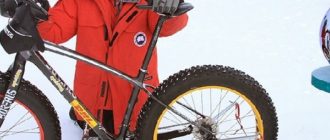Every parent in the Soviet era thought it was their duty to buy their child a Shkolnik bicycle. At that time, there was not much choice, and this bike was quite capable of doing the job: teenagers aged 10-14 rode it in the streets and yards, went with their parents to the cottage, and also used the bicycle as their primary means of transportation.
Today, such bikes can be seen in private collections. Some enthusiasts use “Shkolnik” bikes as a basis, supplementing it with modern components, turning the rarity model into an original and colorful bike, which is not inferior to modern counterparts. Today we will understand why some bicycles of the era of the USSR are in demand even today, we will analyze the characteristics of the bicycle “Shkolnik”, as well as tell you what is special about Soviet bicycles.
History of appearance
The model under discussion was produced by the “GAZ” plant in Nizhny Novgorod. During the war years, bicycle production was suspended – the enterprise specialized in the manufacture of military shells and weapons. Only in 1956 the production of two-wheeled transport was restored. The produced models were aimed at the Soviet youth.
Throughout the history of production, the design of “Shkolnik” has repeatedly changed. At first, GAZ produced samples of two-wheeled transport for Soviet boys and girls. Adult models for men featured a closed frame, and in women’s models the upper tube was located slightly lower. In recent years, the factory established the production of universal bikes with an open frame.
The model under discussion was designed for children aged 11 to 13 years, but the “Shkolnik” was also used by younger children. By those standards, the price of bike “Shkolnik” was tangible for the family budget, but many parents still gave their children reliable and lightweight bikes, which opened up new horizons for children.
Features
Shkolnik bicycles were not particularly superior to their competitors. They were relatively simple and reliable designs, which are quite able to cope with the tasks:
- Get from point “A” to point “B.”
- Rarely break down.
Initially, bicycles were assembled on closed-type frames, which led to some rigidity. A little later, the male models are equipped with an additional saddle for a passenger, but after a while this idea seemed to developers unsuitable, and began collecting bicycles on open frame folding type. By the way, it made it much easier to store the bike in winter. If before it took up a lot of space in the apartment, with the advent of folding designs it became possible to significantly reduce the size of the bike.
“Schoolboys” were distinguished by the primitive geometry of the frame, high handlebars and saddle. Other technical characteristics:
- The wheel diameter of the “Shkolnik” was 510 mm. The current counterpart is 20-inch wheels.
- The tires were 1.25 inches wide. The bikes of that time had regular slick tires.
- The front sprocket has 32 teeth and the rear sprocket has 16 teeth.
It is worth noting that the bike was lightweight – the weight of the bike was a little over 9 kg. Accordingly, even primary school age children could ride it. As an additional equipment was used a pump and a rear rack.
Differences from new models
Today it is not easy to find a working bicycle “Shkolnik”. Given that the bikes stopped being produced back in 1996, even the highest quality model will not withstand the destructive force of time. In the Soviet Union such bikes were of great value, so their owners reverently treated their iron horses and protected them from any damage.
Today a couple of Schoolboys are in private collections. At the exhibitions of rare models it is possible to see several tuned models of the bygone era. The design of “Shkolnik” is very successful, but not for the modern cyclist, who quickly got used to the additional options, significantly facilitating the ride. The main differences from the new models:
- Absence of a support footrest (there are not even loops for installation).
- The outdated frame scheme.
- The changed configuration of a handlebar.
- Use of back wheel brake, which was installed inside the hub.
- No additional brakes were used.
The factory that produced the Shkolniks, there were special hooks for the pump. The frame also had a leather case for tools, which can come in handy on the road. Today, the leather pouch is replaced by a compact repair kit that includes everything that can come in handy when you have a punctured tire.
Tips for use
No matter how reliable your bike is, every piece of equipment needs proper care, which consists of the following points:
- Regular cleaning and lubrication of the running parts. Dust, dirt and water have never been good for metal components.
- Difficult repairs should be done in a repair shop. If you have even the slightest doubt in your abilities, to give the bike in repair is better to the person who repeatedly faced with this problem.
- Protect your bike from moisture. Riding in puddles or in the rain – it’s fun and great. But the bike is clearly not to the taste of water procedures. So you should clean and dry it as thoroughly as possible.
If you want to enjoy the impeccable condition of your bike, you should take good care of it. Looking at the vintage models, involuntarily wonder how people manage to maintain the integrity of all the mechanisms and beauty of the model. The fact is that before “Schoolboy” not everyone could afford, so the attitude toward things was appropriate.
Conclusion
Nowadays, the bicycle “Shkolnik” can be seen in private collections. Judging by the time, the design of the bike was distinguished by the strength of mechanisms and the reliability of all connections. “Shkolnik” was designed for teenagers, but the bike was also ridden by younger children.







